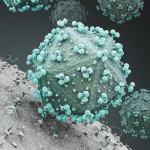It is possible to “boost” certain immune cells to enable them to kill HIV-infected reservoir cells that have been awakened from their dormant state, at least in a laboratory setting and in mice. Publishing their findings in the journal Nature, researchers drew immune cells and HIV-infected reservoir CD4 cells from 25 HIV-positive people and then studied those cells in the laboratory and in mice altered to have human immune systems.
Ten of the HIV-positive people stared antiretroviral therapy within three months of infection (“early”), and the other 15 started after three months of infection (“late”). When studying the cells taken from those who were treated early, the researchers found that the participants’ “killer” CD8 cells were capable of seeking out and destroying the HIV-infected reservoir cells that had been brought out of latency. This was not the case for those who were treated late: Almost all of the virus in their reservoir cells had mutated to the point that it could evade detection by the particular CD8 cells that are usually the dominant force in the pathogen-killing army.
There were, however, other CD8 cells in the late testers’ immune systems that could detect the HIV-infected reservoir cells, if not actually kill them. To jump this hurdle, the scientists boosted the capacity of these CD8 cells by stimulating them with synthetic peptides representing various regions on HIV proteins, including unmutated regions. The boosted cells then successfully killed the HIV-infected reservoir cells in both the laboratory and the mice.
The researchers concluded that such boosting could be a component of a therapeutic vaccine that would be an element of an HIV-cure strategy.
To read a press release about the study, click here.
To read the study abstract, click here.
Advertisement
Advertisement
Advertisement






6 Comments
6 Comments